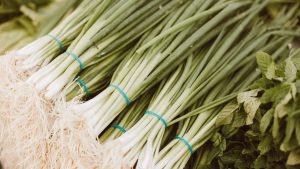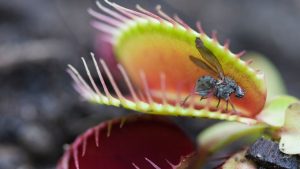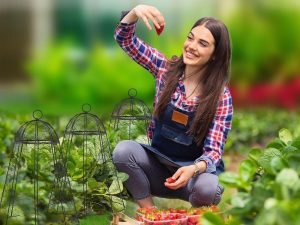Last Updated on April 10, 2024 by teamobn
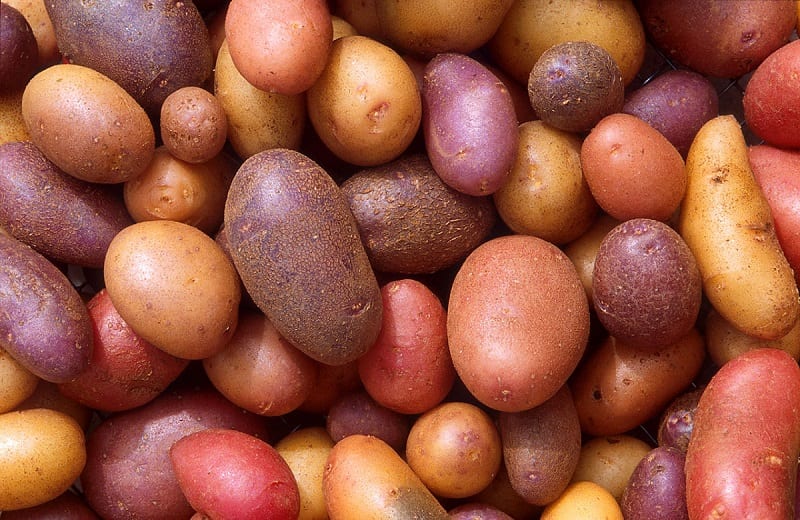
You can grow vegetables and even potatoes indoors in your apartment with the right materials and knowledge. All you need is a 2.5-gallon container, potting mix, and seed potatoes that you can buy online. Place your container on a sunny windowsill and enjoy fresh produce.
Continue reading to learn how you can grow potatoes indoors.
How to Grow Potatoes Indoors
Contents
The easiest, quickest way to grow potatoes indoors is to select potatoes that have already sprouted. This means your seed potatoes should have at least one eye – preferably more – with a protruding sprout.
If your potatoes have not yet sprouted, you can chit them yourself. Chitting is the process of preparing potatoes for planting.
To chit your potatoes, find the eye of the tuber that looks most promising. This is usually one that has already begun a tiny sprout. With this part facing up, place each potato in an appropriate container – an egg carton will do.
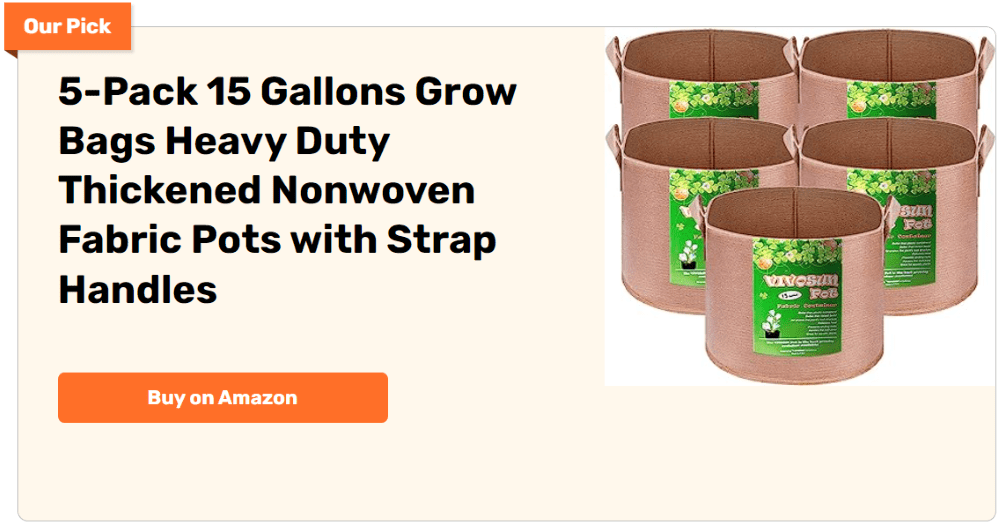
Keep your potatoes near a window with natural light and watch the sprouts grow over the next few days or weeks.
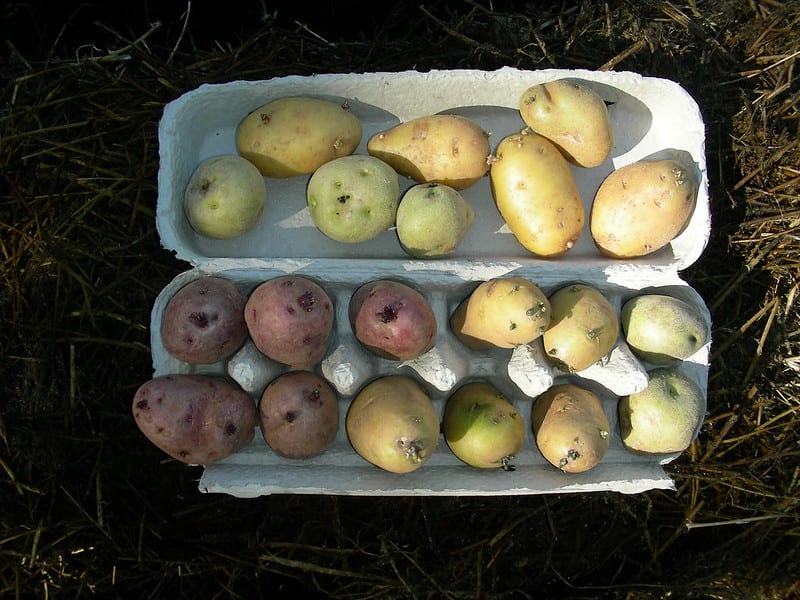
Preparing Seed Potatoes for Planting
Once your potatoes have sprouted, you need to ensure that they are of a size for planting. If your potatoes are about two inches or less in diameter, you can plant them whole. If not, they’ll need to be cut.
In the case of the latter, cut each potato into 2-inch chunks. Make sure that each piece has at least one or two sprouts. You should then store the pieces at room temperature for two to three days to allow them to heal.
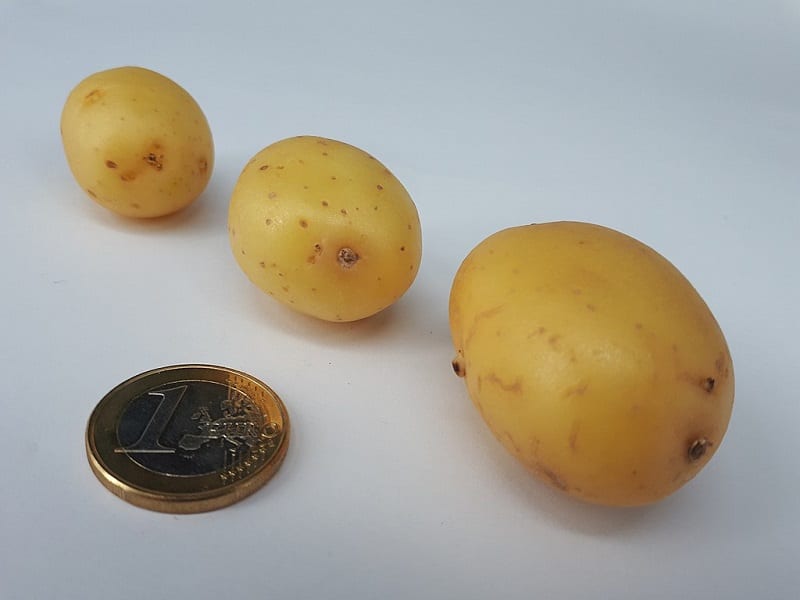
(Photo: Fructibus/Wikimedia Commons)
Choosing Containers
Use the time to gather potting mix and containers as you grow potatoes indoors. Outdoors, you can grow potatoes in just about any container. But since you are growing your spuds indoors, you’ll need a container that permits the best growing conditions possible.
That’s not to say that spuds are choosy about containers. You can use a gardening pot, a plastic bucket, or even a bag of fertilizer.
Just make sure your container is several inches tall and has at least a 2.5-gallon capacity. If you grow potatoes in anything smaller, you will likely harvest small – or few – potatoes.
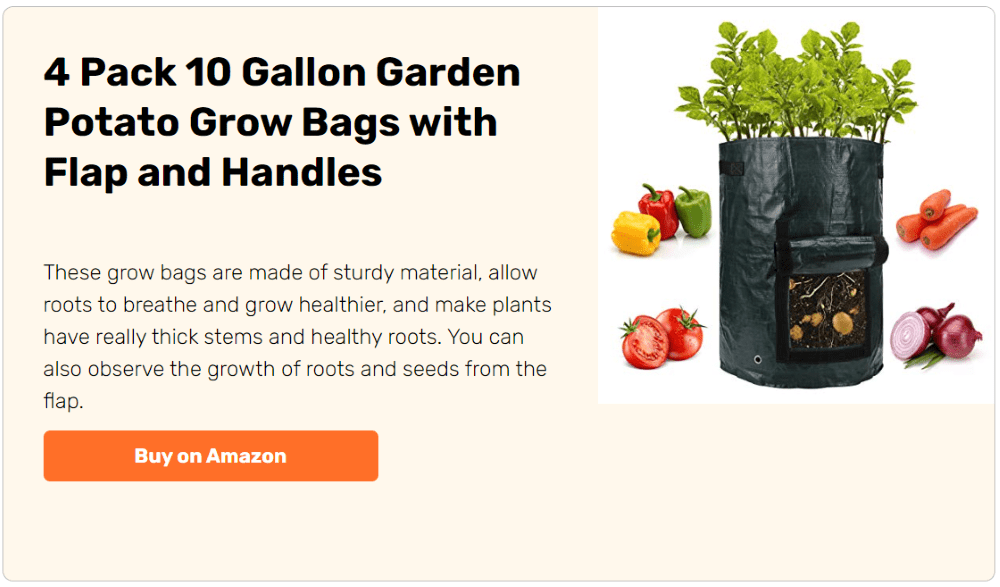
Preparing the Medium to Grow Potato
Drainage and soil condition are important. Potatoes do not thrive in soggy soil. If your container does not have drainage holes at the bottom, poke or drill a few holes through.
To further ensure adequate drainage, pour a three-to-four-inch layer of gritty soil or small pebbles into the bottom of your container. Then, fill the rest of the container with potting mix within a few inches of the rim.
If you have more alkaline than acidic soil, consider adding sulfur to the mixture. Sulfur helps potatoes feed more efficiently.
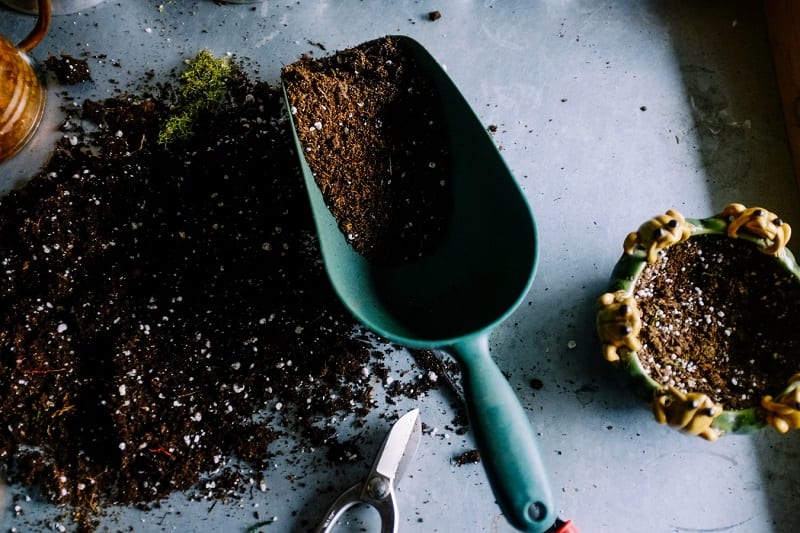
Planting Your Seed Potatoes
If you have a wide container, you can place two or three potatoes on top of the soil. Each potato should have its sprouting end facing up. If you have smaller containers, plant one potato in each.
Each potato should have its most productive sprout facing upwards. Cover each potato with about two more inches of loose soil. Water the soil until it’s sufficiently moist – not soggy. Again, you do not want to drench your seed potatoes.
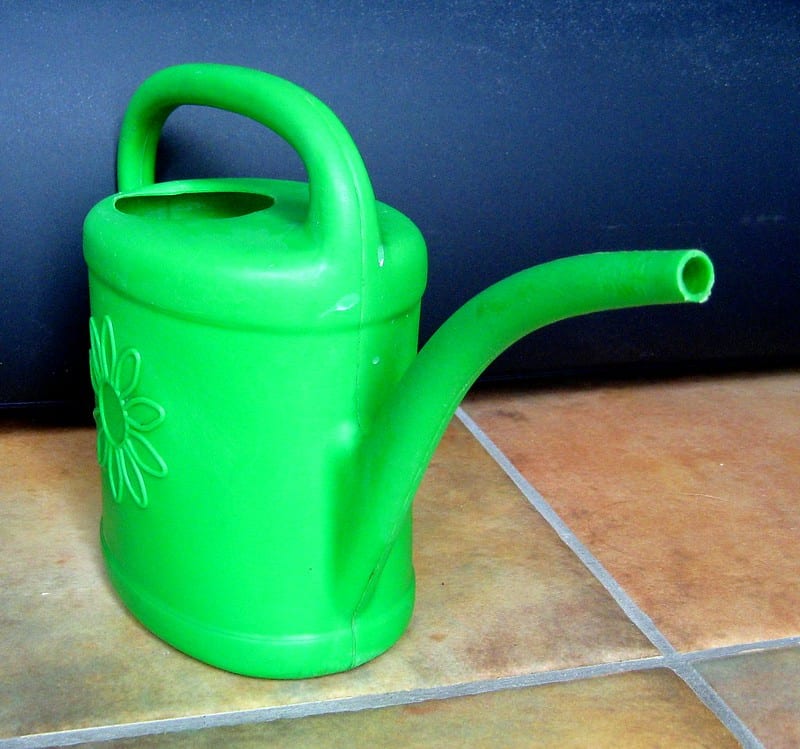
Caring for Potato Plants
Caring for your potato plants is simply a matter of ensuring them adequate sunshine and water. Place your containers on a sunny windowsill or in a corner of your apartment that receives full sun several hours each day.
The plants will not need frequent watering, but you should provide them with a consistent supply of water by keeping the soil moist.
Check on the soil every two to three days, maintaining proper soil moisture throughout. You can add a post-planting organic fertilizer to your soil for added nutrients to aid growth. If you decide to do so, dilute your fertilizer, as potatoes don’t need much to boost growth.
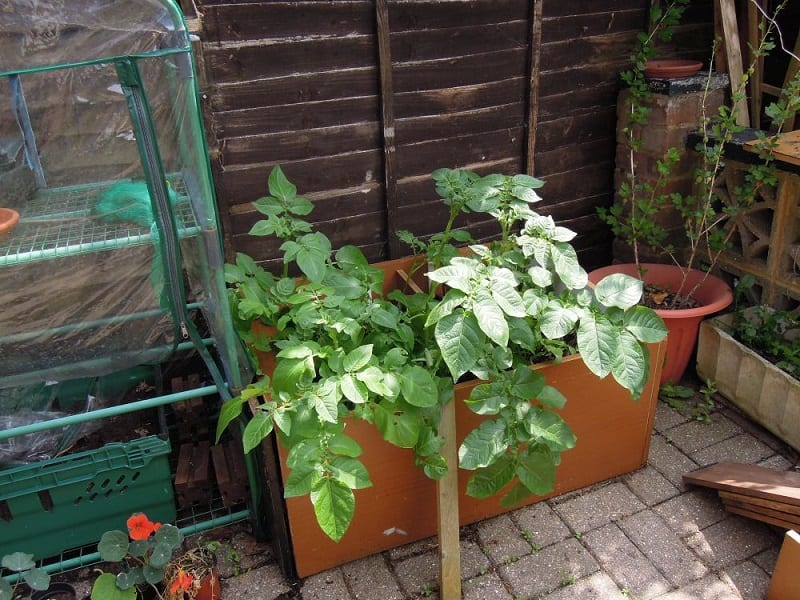
Hilling the Soil
Your potatoes will grow, and you’ll need to add more soil as they do. The process of adding soil is called hilling and there is a simple method to it. Just create a mound of soil up and around the stalk of the potato plant.
The hilling process keeps your potatoes under the soil, protected from exposure to light. Continue to do this as your plant grows. You should have a mound of soil about six inches high by the time your spuds are ready for harvest.
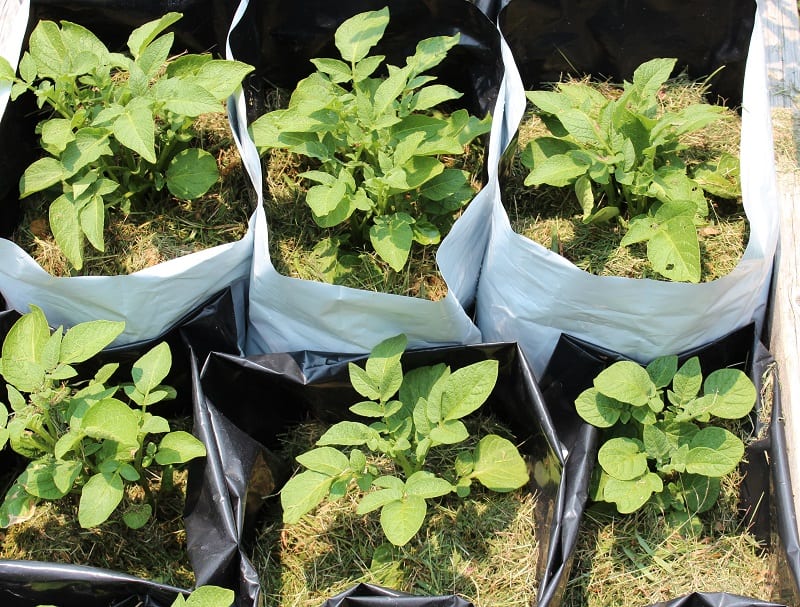
(Photo: Doug Becker/Wikimedia Commons)
Harvesting Your Potatoes
The tubers will usually be ready for harvest once the leaves of plants turn yellow. You can also wait until the plants die off completely to ensure maximum growth of the spuds.
To check for the maturity of the tubers, rub your thumb gently against the skin of one potato. If the skin stays firmly in place, your potatoes are ready for harvest.
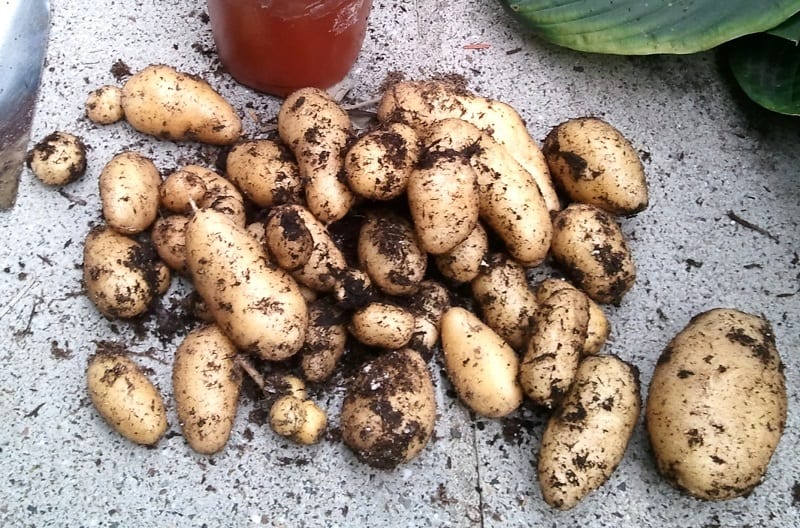
To harvest your potatoes, gently pull the plant from the container. Pull off each spud from the plant. Brush off the soil from the tubers and allow them to dry in the sun for a few hours before cleaning and cooking.
Are you ready to grow potatoes in your apartment? Give it a try and tell us about your experience here.
Pest and Disease Management Indoors
Growing potatoes indoors offers a unique set of advantages, especially in controlling the environment to reduce pest and disease risks. However, indoor gardens are not immune to these challenges. Effective management and preventative measures are crucial to ensure a healthy, thriving crop.
Here’s how you can protect your indoor potato plants from common pests and diseases.
Identify Common Indoor Pests
Indoor potato gardens may encounter pests such as aphids, spider mites, and fungus gnats. Aphids are small, soft-bodied insects that can cause leaves to yellow and stunt plant growth. Spider mites, though harder to see, leave behind telltale webbing and can cause leaves to become discolored. Fungus gnats, attracted to moist soil, can harm young plants and roots.
Preventative Measures
Prevention is key in managing pests and diseases indoors. Ensure good air circulation around your potato plants to reduce humidity levels, making the environment less inviting to pests. Regularly inspect your plants for signs of infestation or disease, focusing on the undersides of leaves where pests often hide. Keep the area around your plants clean and free of debris to minimize hiding spots for pests.
Natural Pest Control Solutions
For aphids and spider mites, a gentle spray of soapy water on the affected areas can be effective. Introducing beneficial insects, like ladybugs, can help control aphid populations naturally. For fungus gnats, reducing watering to allow the top layer of soil to dry out can curb their lifecycle. Sticky traps can also catch adult gnats, reducing their numbers.
Managing Diseases
Diseases like potato blight and powdery mildew can also affect indoor potatoes. To prevent diseases, use a sterile potting mix and avoid overwatering, which can create conditions conducive to fungal growth. If signs of disease appear, remove and dispose of affected plant parts immediately. For fungal diseases, applying a natural fungicide, such as neem oil, can help control the spread.
Routine Monitoring
Regularly check your indoor potato plants for any signs of distress. Early detection of pests or diseases is crucial for effective management as you grow potatoes indoors. Implementing a routine inspection schedule can help you catch issues before they escalate, ensuring your indoor potato garden remains healthy and productive.
By taking these steps for pest and disease management, you can grow potatoes indoors successfully with minimal issues. With the right care and preventative measures, your indoor potato garden can flourish, providing you with a bountiful harvest.
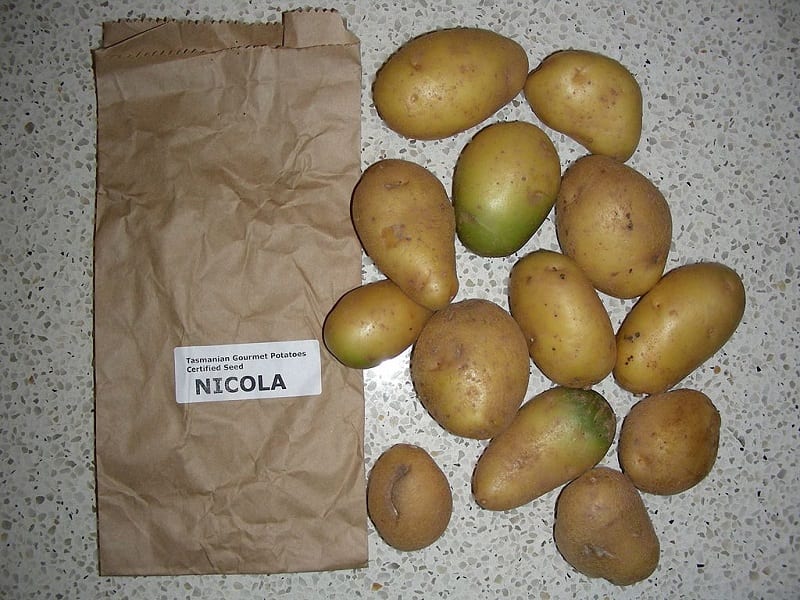
(Photo: Doug Beckers/Wikimedia Commons)
Watering Techniques and Moisture Management
When you decide to grow potatoes indoors, understanding the right watering techniques and moisture management becomes essential. To grow potatoes indoors successfully, it’s crucial to strike a balance in soil moisture, ensuring your indoor potato plants have the optimal conditions to thrive.
Here’s how you can manage watering and moisture to best support your indoor potato garden.
Assessing Water Needs to Grow Potatoes Indoors
To grow potatoes indoors, one must regularly monitor the soil’s moisture level. The need for water can vary based on several factors, including the size of your container and the indoor climate. To grow potatoes indoors effectively, check the soil moisture before watering to prevent over or under-watering. This precaution is vital for the health of your indoor potato plants.
Optimal Watering Practices for Indoor Potato Gardens
Effective watering is key to grow potatoes indoors. When watering your potatoes, ensure a thorough application that reaches the roots, where it’s most needed. For those looking to grow potatoes indoors, avoiding foliage wetting is crucial, as this can lead to disease. The goal is to keep the soil moist but not waterlogged, which is a delicate balance in the quest to grow potatoes indoors.
Importance of Drainage in Indoor Potato Cultivation
Proper drainage is paramount when you grow potatoes indoors. Ensuring your containers have adequate drainage holes prevents water from pooling at the bottom, which is essential to grow potatoes indoors successfully. This step helps avoid root rot and other moisture-related diseases, which can be a challenge when you grow potatoes indoors.
Utilizing Mulch to Grow Potatoes Indoors
Applying a layer of mulch can significantly benefit those looking to grow potatoes indoors by helping retain soil moisture and regulate temperature. This practice is especially beneficial for indoor potato gardens, as it reduces the need for frequent watering and helps maintain an ideal growing environment for potatoes indoors.
Adjusting Watering as Your Indoor Potatoes Grow
As you grow potatoes indoors, be aware that their watering needs can increase during the growing season. Regular monitoring and adjusting your watering schedule is a critical aspect of how to grow potatoes indoors. This ensures that the plants receive the right amount of water at different growth stages, which is essential for anyone aiming to grow potatoes indoors successfully.
By focusing on these watering and moisture management tips, you can create the perfect conditions to grow potatoes indoors. Remember, the goal is to maintain consistent soil moisture, ensuring your indoor potato plants are healthy and productive. With the right approach, you can enjoy a bountiful harvest from your indoor potato garden.
Conclusion
Growing potatoes indoors offers a fantastic opportunity to enjoy fresh, home-grown spuds regardless of outdoor space limitations. With proper care, including adequate lighting, watering, and pest management, anyone can harvest a healthy potato crop inside their home. Embracing these practices ensures a rewarding indoor gardening experience, yielding delicious potatoes ready for your table.
We have more spave-saving gardening methods to growing vegetables at home. Check out our urban gardening strategies post next!

